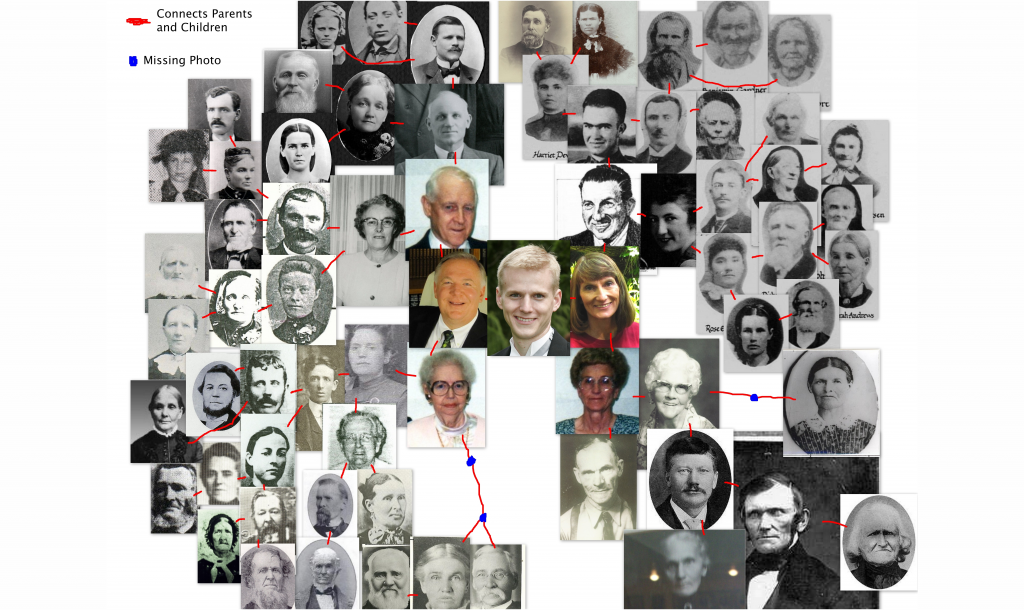Prelude
For ages I felt like there was no point for me to do family history work. My family is about as Mormon as it gets. Sure I can claim 7th generation Mormon status, but the thing is that I don’t have anyone in my family tree who wasn’t Mormon as long as Mormonism has been around. 30 of my 32 great-great-great grandparents were Mormon (the missing 2 died before missionaries got to that part of Denmark). I had great-great-great grandparents who were meticulously doing their genealogy during their lifetimes, so what could I add?
My father was adopted at birth. He always wanted to be able to contact his birth mother to thank her for putting him up for adoption as he had had a great life with his parents. He also wanted to learn more about family health history. I didn’t really start to consider my biological family history until I put together a graphical family tree with photographs of each person. It was one of those situations in which what you’ve always known still hadn’t fully registered in your mind. It wasn’t until looking at the visual similarities with my ancestors on my mom’s side, and on my dad’s side (up to his adopted parents) that I realized that my dad’s biological parents still were a part of my tree. I inherited 50% of my DNA from them. In a very real way they were part of my tree.
The year after I made the photo family tree my wife got me a DNA kit from 23andme.com for our anniversary. In grad-school I learned way more about microbiology and genetics than I’d ever wanted to know (and then promptly forgot most of the details). I had been enrolled in a course which would have had me doing my own research using my raw DNA data had I remained enrolled in it. Anyway, the point is that I had been excited to learn more and so my wife (being the superstar that she is) totally got the perfect present. After spitting in a tube and mailing it off, I waited several weeks for the results.
When the results were in, there was a TON of amazing information. I could see which medicines I would be more or less sensitive to. I could see how my DNA gave me increased and decreased risks for a number of health problems. I discovered that I am 3.3% Neanderthal (which puts me in the 99% percentile of people with Neanderthal DNA). This was all great, but the biggest surprise was in the DNA relatives section.
Prerequisite information
Before I go over that, I’d better do a quick review of DNA because in order to explain how I found my biological grandparents there is going to be some technical jargon. If you are male, your y-chromosome is identical to your father’s and his father’s. The female counter-part is that the mitochondria we have in all of our cells come from the mother’s egg. (Side note: if you heard about the UK approving human embryos with the DNA of 3 people, it is about the mitochondrial DNA. The chromosomal DNA is still {currently} from just two people and the other is the egg donor). We all have 23 chromosomes, each is a pair of chromatids. We get one of each pair from our mother and one of each pair from our father. So your DNA is exactly 50% from each. However, you do not have exactly 25% of your DNA from each grandparent. This is because of meiosis.
As seen in the animation above, the chromosomes in a parent’s cell are copied. Let’s say that the green are from your mother and the yellow from your father. Next, the now doubled chromatid from your mother is situated right next to the doubled chromatid from your father. Now there is some “recombination” meaning that a portion of your mom’s chromatid swaps with the same portion of your dad’s. Then these separate into two daughter cells, which then also separate. This recombination process is not going to happen on exactly 50% of the chromatid, it is random. You can see that in each of the daughters. This is why you don’t have exactly 25% from each grandparent. This process is happening on all 23 chromosomes, so the law of averages comes into play here and you will get approximately 25%.
So you share exactly 50% of your DNA with your parents, but any relation other than parents (or identical twins) gets fuzzy on the percentages. For example, you share
~50% of your sibling’s DNA
~25% of any one of your grandparents’, aunts’, uncles’, nieces’, nephews’, and half siblings’ DNA
~12.5% of any one of your great-grandparents’, great-aunts’, great-uncles’, cousins’, half-uncles’, half-aunts’ DNA
and so on.
Because the recombination is random and finite, this percentage rule also means that as you get more distantly related, you increase the chance that you’ll actually not share any DNA with them. There are some of my 3rd cousins that share some DNA segments with me but not with my sister. However, it might be that the tiny segment we share will be passed on to one of my kids and one of the 3rd cousin’s kids, and maybe even grandchildren. So even though the % of DNA shared is the same, the level of relationship can vary. The smaller the % shared DNA, the greater the uncertainty in how you’re related.
What is also cool is that now that I know I share this segment with my 3rd cousin, if we can determine how we are related through genealogy, we can then definitively say which of our ancestors gave us that segment. I’ve been trying to map out my own DNA to see which segments of which chromosomes came from with ancestor. Here is a sample of where I’m at with that map:
This shows chromosomes 2-9. You can see that each has two rows (the chromatid I have from my mother and the one from my father). You can also see that they are different lengths. When I am able to find out which segment I share with someone and we’re also able to find who our common ancestor is, then I can finally mark that segment as the segment I got from either the common ancestor (if the spouse of the ancestor was different for each of us) or the common ancestor’s child (for the more common situation in which you share a common grandmother and grandfather). On this chart, I have it set up so that I can change which ancestor’s name is displayed. If I change the bottom right cell (saying 9th Great) to some other level of grandparent, then it will show that ancestor’s name on the segment. Zeroth just means my grandparents. The random pink segments should really be 0th, but I’ve been too lazy to finish changing the worksheet. I’m interested to see which of my genes that predispose me to things (such as Alzheimer’s) came from which ancestor. This also becomes helpful when I find someone who shares one of those segments with me but who doesn’t know their genealogy because I can tell them exactly who I got that segment from, which can be a big clue in trying to map your family tree. Hopefully I adequately covered the technical info, so on to the story!
The Story
I saw that there was someone else on 23andme who shared 11.9% of my DNA. This would mean that he was likely a cousin or a half-uncle. After reaching out to him I discovered that he was indeed my dad’s half-brother. Because they had the same maternal haplotype (meaning mitochondrial DNA) I knew that they shared the same mother. He was also adopted and also knew nothing about his birth parents.
I later got a new match with someone (let’s call Jared) who shared about 2% of their DNA with me and 3% with my dad. I was guessing that we were likely 2nd or 3rd cousins. I found another match that was related to both of Jared and me, but it was a likely a very distant match. I looked through each of their family trees online to see if I could discover how they were related to each other. I finally found their common ancestor. This meant that it was very likely also my ancestor. So I had very likely tracked down 1 of my dad’s 4 sets of great-grandparents.
I decided to try to find out how my dad might be related to them. I first looked at the few clues my dad had. We knew his mom had earned an associates degree at SUU. So I contacted them and they directed me to digitized versions of their yearbooks in the decade I assumed my grandma had attended. I had her age at the time of my dad’s birth, so I also had an approximate birth-year. I tried then looking at the children, and grandchildren, and great-grandchildren of the common ancestors we shared with Jared to see if any of them attended SUU during that decade. I had no luck.
The next breakthrough happened when I found another distant cousin that shared 3% DNA with my dad and who also had the same maternal haplotype! This was great, I just needed to know who their mom’s mom’s mom’s mom was, and then look at her daughters’ daughters’ daughters, one of which was hopefully my grandma. I did this and went again to the SUU yearbooks. When I looked at one of the possibilities, she looked like my dad. So I looked up her contact info online and gave all of the info I had to my dad. If he wanted to try to contact her he could.
He did and discovered that she was his aunt. We learned about my grandma’s family, health issues, pioneer stories (yes they were also Mormon). My dad called his birth-mother and was able to thank her for giving him up for adoption and to let her know that he’d had a good life and appreciated her sacrifice. He was able to do so, however, his mother didn’t really want any future contact. His aunt however really wanted to know more about us, so even though we haven’t really connected with my grandma, we now know more about her parents/siblings. This also gave us a new clue for finding my dad’s dad; his first name was Doug. We also found out that Doug never knew about my dad’s existence.
Within 2 weeks of finding my paternal grandmother, I had a new match with someone who shared 6% of my dad’s DNA and was also related to Jared. He verified that he was a descendant of the same couple that I had suspected were my dad’s great-grandparents. Because he shared about twice as much DNA, I assumed that maybe we shared one of their kids as a common ancestor. I gave him all the clues I had about my dad’s father. A day later he replied with a family tree that showed each of the kids’ kids for multiple generations and pointed out the one he thought was my dad’s dad. So I started to google search for more information on this guy. My dad then found a newspaper article about his father: http://www.azcentral.com/community/mesa/articles/20131223unlikely-reunion-bridges-past-present.html
Apparently just months earlier his half-brother (whom we didn’t know existed) had been reunited with his father. My dad reached out to his newly discovered half-brother Boyd and he learned some more about his father. Boyd didn’t think that contacting Doug was the best idea given his current state and my father agreed.
So in less than a month we went from knowing nothing about my dad’s parents to knowing who they were. I’ve now been trying to trace back my biological family tree. If you are interested in learning more about the details of how to use DNA with family history research, feel free to contact me. I’m happy to share what I’ve learned.
If you are still reading this at this point, I’d like to share an idea I have and which I plan on attempting to create. I know several segments which I received from Wilford Woodruff. I would love to get a large group of his descendants to compare DNA. If we find shared segments between descendants from different wives then we know it was Wilford Woodruff’s DNA. We could theoretically reconstruct his genome. There would very likely be missing pieces, but I think it would be interesting. With that we could also look to see what increased or decreased risks he had for his physical and mental health. So if you’re a descendant of Wilford Woodruff and you have (or want to have) your DNA sequenced, contact me and let’s do this.








This was really cool! It’s amazing the tools we now have available to us through science. There was a great story in the January Ensign (“Why Michigan?”) about a man who found his birth parents through DNA testing (and there’s a great twist I won’t give away).